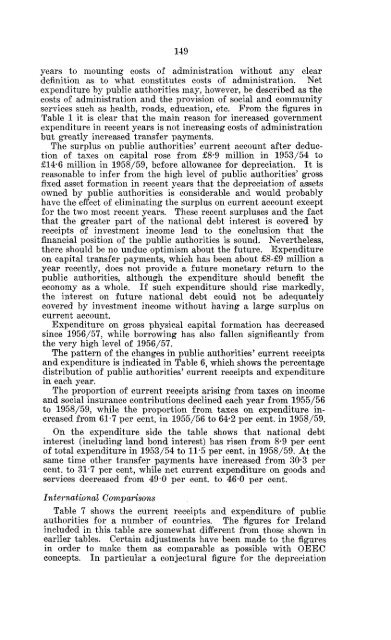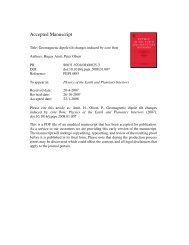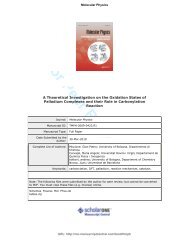An Analysis of Government Revenue and Expenditure in ... - TARA
An Analysis of Government Revenue and Expenditure in ... - TARA
An Analysis of Government Revenue and Expenditure in ... - TARA
You also want an ePaper? Increase the reach of your titles
YUMPU automatically turns print PDFs into web optimized ePapers that Google loves.
149<br />
years to mount<strong>in</strong>g costs <strong>of</strong> adm<strong>in</strong>istration without any clear<br />
def<strong>in</strong>ition as to what constitutes costs <strong>of</strong> adm<strong>in</strong>istration. Net<br />
expenditure by public authorities may, however, be described as the<br />
costs <strong>of</strong> adm<strong>in</strong>istration <strong>and</strong> the provision <strong>of</strong> social <strong>and</strong> community<br />
services such as health, roads, education, etc. From the figures <strong>in</strong><br />
Table 1 it is clear that the ma<strong>in</strong> reason for <strong>in</strong>creased government<br />
expenditure <strong>in</strong> recent years is not <strong>in</strong>creas<strong>in</strong>g costs <strong>of</strong> adm<strong>in</strong>istration<br />
but greatly <strong>in</strong>creased transfer payments.<br />
The surplus on public authorities' current account after deduction<br />
<strong>of</strong> taxes on capital rose from £8*9 million <strong>in</strong> 1953/54 to<br />
£14-6 million <strong>in</strong> 1958/59, before allowance for depreciation. It is<br />
reasonable to <strong>in</strong>fer from the high level <strong>of</strong> public authorities' gross<br />
fixed asset formation <strong>in</strong> recent years that the depreciation <strong>of</strong> assets<br />
owned by public authorities is considerable <strong>and</strong> would probably<br />
have the effect <strong>of</strong> elim<strong>in</strong>at<strong>in</strong>g the surplus on current account except<br />
for the two most recent years. These recent surpluses <strong>and</strong> the fact<br />
that the greater part <strong>of</strong> the national debt <strong>in</strong>terest is covered by<br />
receipts <strong>of</strong> <strong>in</strong>vestment <strong>in</strong>come lead to the conclusion that the<br />
f<strong>in</strong>ancial position <strong>of</strong> the public authorities is sound. Nevertheless,<br />
there should be no undue optimism about the future. <strong>Expenditure</strong><br />
on capital transfer payments, which has been about £8-£9 million a<br />
year recently, does not provide a future monetary return to the<br />
public authorities, although the expenditure should benefit the<br />
economy as a whole. If such expenditure should rise markedly,<br />
the <strong>in</strong>terest on future national debt could not be adequately<br />
covered by <strong>in</strong>vestment <strong>in</strong>come without hav<strong>in</strong>g a large surplus on<br />
current account.<br />
<strong>Expenditure</strong> on gross physical capital formation has decreased<br />
s<strong>in</strong>ce 1956/57, while borrow<strong>in</strong>g has also fallen significantly from<br />
the very high level <strong>of</strong> 1956/57.<br />
The pattern <strong>of</strong> the changes <strong>in</strong> public authorities' current receipts<br />
<strong>and</strong> expenditure is <strong>in</strong>dicated <strong>in</strong> Table 6, which shows the percentage<br />
distribution <strong>of</strong> public authorities' current receipts <strong>and</strong> expenditure<br />
<strong>in</strong> each year.<br />
The proportion <strong>of</strong> current receipts aris<strong>in</strong>g from taxes on <strong>in</strong>come<br />
<strong>and</strong> social <strong>in</strong>surance contributions decl<strong>in</strong>ed each year from 1955/56<br />
to 1958/59, while the proportion from taxes on expenditure <strong>in</strong>creased<br />
from 61-7 per cent, <strong>in</strong> 1955/56 to 64-2 per cent, <strong>in</strong> 1958/59.<br />
On the expenditure side the table shows that national debt<br />
<strong>in</strong>terest (<strong>in</strong>clud<strong>in</strong>g l<strong>and</strong> bond <strong>in</strong>terest) has risen from 8*9 per cent<br />
<strong>of</strong> total expenditure <strong>in</strong> 1953/54 to 11*5 per cent, <strong>in</strong> 1958/59. At the<br />
same time other transfer payments have <strong>in</strong>creased from 30-3 per<br />
cent, to 31*7 per cent, while net current expenditure on goods <strong>and</strong><br />
services decreased from 49*0 per cent, to 46*0 per cent.<br />
International Comparisons<br />
Table 7 shows the current receipts <strong>and</strong> expenditure <strong>of</strong> public<br />
authorities for a number <strong>of</strong> countries. The figures for Irel<strong>and</strong><br />
<strong>in</strong>cluded <strong>in</strong> this table are somewhat different from those shown <strong>in</strong><br />
earlier tables. Certa<strong>in</strong> adjustments have been made to the figures<br />
<strong>in</strong> order to make them as comparable as possible with OEEC<br />
concepts. In particular a conjectural figure for the depreciation
















